How to turn the high school “hamburger” essay into a university-level paper
It goes by many names: the 5-paragraph essay, three-tier paper, or 1-3-1 model, to name a few. Many of you know it as the “hamburger” essay – an easy-to-follow model for writing papers that’s often taught in North American high schools.
During my first semester of undergrad, I heard it again and again from my professors and TAs: don't submit a hamburger essay. "Forget everything you learned in high school," they told me, "university writing is different!"
I had always done well on my high school writing assignments. I thought essay writing in university would be a breeze. So, the idea of throwing away all my past knowledge and practice felt confusing and overwhelming. If I wasn’t supposed to write essays in university the same way I wrote them in high school, then how was I supposed to write at all? And where was I supposed to learn these mysterious new writing techniques, anyway?
Now, after many years of honing my academic writing skills and becoming a writing instructor myself, I’m here to say, loud and proud: I love the hamburger essay.
This is somewhat of a controversial statement in higher education. For years, many professors have condemned the “hamburger” model of essay writing, resenting its rules and restrictions. And while many of these critiques are valid, I believe there are too many valuable aspects of the hamburger essay to throw it away altogether. In fact, many of the same techniques that make a hamburger essay great, can also be used to craft a quality academic paper.
So no, you don’t need to “forget everything you learned in high school” when it comes time to write your first university essay! Keep reading to learn how you can use turn your high school hamburger essay into a strong university-level paper.

What is the hamburger essay?
The hamburger essay is well-known and well-loved because of its simple and easy to remember structure. If you're new to the hamburger essay, check out the diagram below to learn more about how it works.

In short, each ingredient of the hamburger represents a different paragraph of the essay. It starts with an introduction paragraph and ends with a conclusion paragraph, represented by the top and bottom buns, respectively. Just like a real burger bun, these paragraphs frame the juicy contents inside – the body paragraphs – which are each represented by a different topping: lettuce, tomato, or patty.
Pay attention to the order of toppings in the hamburger essay. The lettuce comes first; it’s light and flimsy, representing one of the lighter arguments of the paper. The tomato is somewhat more robust (in terms of argument), while the patty at the end is the true “meat” of the essay. Just like the toppings of a hamburger in real-life, the body paragraphs build on one another to fill out the paper, giving it substance and flavour.
How to use the hamburger model in university
If you’re already familiar with the hamburger or 5-paragraph essay model, there are many great aspects of it that you can keep and adapt in your university essay writing . Keep reading to learn how!
1. The top bun (a.k.a the introduction paragraph)
The hamburger essay begins with a strong introduction paragraph (the top bun) that sets up the rest of the paper and presents the essay’s primary thesis statement or argument. In high school, students are often taught to begin their introduction paragraph with the broadest or most general information first, and gradually narrow in on the specifics. They’re also taught to begin the introduction with a narrative hook – a catchy phrase or fact to grab the reader’s attention – and to end the introduction with a “road map,” which outlines what each paragraph of the essay will discuss, in the order of information presented.
Although at the university level, introductions may be longer than one paragraph (depending on the length of the essay overall), they should still begin with more general contextual information first, then narrow in on a more focused thesis statement . This structure helps guide the reader by presenting them with the background information they require for the thesis and body paragraphs to make sense.
You can also keep the introductory “hook” and “road map” pieces of the hamburger introduction, but note the differences in what these elements look like at the university level. While high school writers often try to catch the reader’s attention by asserting a universal or historical truth (e.g. “Since the dawn of time…” or “Throughout history…”), a hook at the university level should remain focused on the specific topic at hand – a surprising fact or statistic works well here.
Additionally, while a high school-level road map might outline the topic of each and every body paragraph in the essay, a university-level road map should be less detailed. Because university papers are typically longer than high school papers, it makes more sense to only mention the paper’s main overarching arguments (if at all) in the road map section, rather than summarize every paragraph.
To learn more about how to write a strong university-level introduction, check out this WCC resource on introductions.
2. The bottom bun (a.k.a. the conclusion paragraph)
The hamburger essay ends with a satisfying conclusion paragraph (the bottom bun) that summarizes its findings and wraps up the paper’s arguments. High school students are often taught to structure their conclusion paragraph in the reverse order of the introduction, beginning with the most specific information and broadening out to the most general . Hamburger essay conclusions often restate the thesis at the start of the paragraph, then go on to summarize each point of the essay.
At the university level, you should continue to structure your conclusion by presenting the most specific pieces of information related to your thesis first, followed by the more general ideas. Structuring your conclusion this way helps transition the reader out of the paper’s arguments and into a broader reflection on the topic .
However, you don’t have to limit yourself to only one paragraph for your conclusion (hint: introductions and conclusions typically make up 10-15% of the essay length overall). And while it’s good practice to remind your reader of the essay’s main arguments and findings, too much repetition can be a bore. Try focusing instead on the significance of the paper’s claims and discoveries to highlight for the reader why your essay matters – why your thesis is significant in a larger context.
For deeper insight into how to write a university-level conclusion, view our conclusions resource here.
3. The toppings (a.k.a. the body paragraphs)
The body paragraphs of a hamburger essay are its meatiest parts (pun intended). In high school, students are often taught to explain, and provide evidence for, their main thesis by presenting three distinct points in three separate body paragraphs, ordered roughly from the weakest point to the strongest. In this model, each body paragraph supports the essay’s thesis by providing a new piece of information to back-up the author’s primary claim. Also, each paragraph articulates its main point in a single topic sentence at the beginning of the paragraph.
For university essays, there’s a lot to like about the hamburger essay paragraph model. For example, it’s important that each paragraph of your university-level paper works to substantiate the paper's overarching thesis statement . This will prevent your essay from going off on tangents – that is, presenting ideas or research that are not directly related to the essay's focused goal. You should also pay attention to the order of ideas presented; while ordering your points from weakest to strongest (as in the hamburger model) isn’t necessary, there should be a logical flow to your ideas . Ask yourself: what does my reader need to understand first in order to understand what’s coming next?
Topic sentences are also super useful in academic papers : they help alert the reader to the paragraph’s main idea and provide context for the evidence presented within the paragraph itself. In a traditional academic essay, readers should be able to read the first sentence (or two) of each paragraph only, and still have a strong idea of the paper’s main arguments and points.
However, university-level essays can – and should – have more than three body paragraphs . This is perhaps the biggest complaint against the hamburger essay structure: that it tricks students into thinking they can only provide three pieces of evidence to back-up their thesis statements. Academic essays, especially research essays, should present the reader with a great breadth of evidence and information to prove their claims. It’s up to you – the writer – to decide how much evidence is needed, and how it can be organized logically into body paragraphs for the reader to follow.
On a similar note, some points in your academic paper will require more than one body paragraph to develop, and that’s ok! Let’s say, for example, that you’re writing an essay on the benefits of free community programming for reducing loneliness amongst senior citizens. It may take only one paragraph to present your research on loneliness amongst seniors, but maybe three or four paragraphs to show why publicly-funded programs are attractive to senior citizens in particular.
While some students believe, based on the hamburger model, that each new paragraph requires a brand new topic or point, in reality, there is more flexibility to the “rules” of academic writing. As long as each of your paragraphs is tackling one coherent idea at a time, you may choose to develop a single point over numerous body paragraphs . This is especially true if you have a lot of evidence to discuss!
To learn more about how to write strong body paragraphs at the university level, check out this WCC resource on body paragraphs.
Final thoughts…
Keep in mind that every writing assignment in university is different and not all papers follow the traditional essay format. In fact, most essay assignments come with specific guidelines from the professor, which you should always follow with care, and ask questions about if you’re unsure.
If you’re transitioning from high school and looking for help with your writing projects, why not check out our new program for first-years, Waterloo Ready to Write ! Or book an appointment with one of our friendly and helpful writing instructors at the WCC. We would love to help you out.
Writing essays in university can be intimidating, especially if you’re new at it. But remember, you’re here for a reason, and you’ve already got a great foundation to start from! Try to think about writing in university as an extension and adaptation of what you already know. If you have an open mind, take your professors’ feedback to heart, and push yourself to try new things, you’ll be setting yourself up for success.
- Link to facebook
- Link to linkedin
- Link to twitter
- Link to youtube
- Writing Tips
Hamburger Paragraph Template for Essay Writing
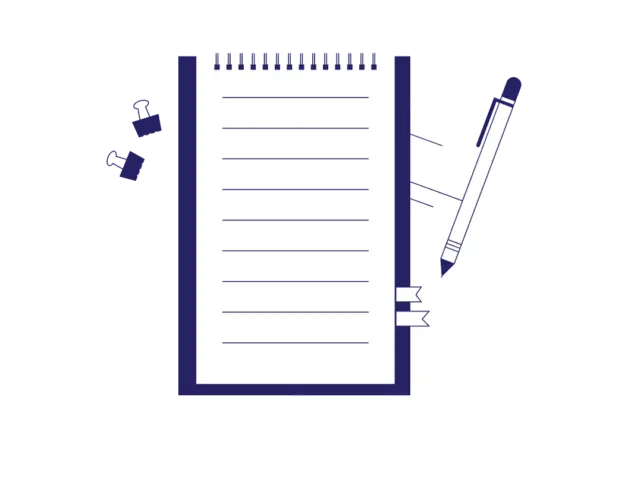
- 3-minute read
- 3rd November 2023
It almost sounds like something you might see on a menu at a fast-food restaurant, but a “hamburger paragraph” is a method of essay writing often taught in schools to help students structure their paragraphs effectively. Just as a burger consists of various layers that come together to create a satisfying whole, an essay is built up of paragraphs that follow a specific structure.
In this blog post, we’ll explore the concept of a hamburger paragraph and how it can serve as a handy template for essay writing.
Hamburger Paragraph Template
The template below lists the “ingredients” of a hamburger paragraph:
Top Bun (Topic Sentence):
Introduce the main idea of the paragraph .
Filling (Supporting Detail #1):
Introduce your first supporting detail or example that backs up your main idea.
Filling (Supporting Detail #2):
Introduce your second supporting detail or example.
Filling (Supporting Detail #3):
Introduce your third supporting detail or example. Note: Depending on the depth required, you may have more or fewer supporting details.
Bottom Bun (Concluding Sentence):
Wrap up the paragraph by restating or summarizing the main idea – or transition to the next paragraph . Ensure that every main point or idea presented in the paragraph is well-supported and rounded off with a conclusion or transition.
Example of a Hamburger Paragraph Using the Template
Here’s a paragraph about dogs written following the hamburger paragraph method:
Find this useful?
Subscribe to our newsletter and get writing tips from our editors straight to your inbox.
Dogs have a reputation for being loyal companions.
Filling #1:
Historically, dogs have been known to travel vast distances to reunite with their owners.
Filling #2:
Many breeds have been specifically bred for their loyalty traits, such as Golden Retrievers and German Shepherds.
Filling #3:
Pet owners’ personal experiences further support the claim, with countless stories of dogs displaying unwavering loyalty in various situations.
Bottom Bun:
With their history, breeding, and the personal anecdotes of many, it’s clear why dogs are cherished for their loyalty.
The hamburger template assists writers, especially those new to essay writing, in assembling a well-structured essay, helping them organize their thoughts and research into a logical format that readers can easily follow. Students can use this structure to ensure they’re fleshing out their ideas adequately and maintaining a logical flow throughout their essays.
So next time you’re writing an essay, think of your paragraphs as a delicious stack of hamburger paragraphs, with each one adding a unique flavor to your overall composition. If you’d like a professional proofreader to review your essay and its structure once you’ve completed your first draft, we’d be happy to help. Check out our essay proofreading services , or try us out by submitting a free sample !
Share this article:
Post A New Comment
Got content that needs a quick turnaround? Let us polish your work. Explore our editorial business services.
5-minute read
Free Email Newsletter Template
Promoting a brand means sharing valuable insights to connect more deeply with your audience, and...
6-minute read
How to Write a Nonprofit Grant Proposal
If you’re seeking funding to support your charitable endeavors as a nonprofit organization, you’ll need...
9-minute read
How to Use Infographics to Boost Your Presentation
Is your content getting noticed? Capturing and maintaining an audience’s attention is a challenge when...
8-minute read
Why Interactive PDFs Are Better for Engagement
Are you looking to enhance engagement and captivate your audience through your professional documents? Interactive...
7-minute read
Seven Key Strategies for Voice Search Optimization
Voice search optimization is rapidly shaping the digital landscape, requiring content professionals to adapt their...
4-minute read
Five Creative Ways to Showcase Your Digital Portfolio
Are you a creative freelancer looking to make a lasting impression on potential clients or...

Make sure your writing is the best it can be with our expert English proofreading and editing.
- PRO Courses Guides New Tech Help Pro Expert Videos About wikiHow Pro Upgrade Sign In
- EDIT Edit this Article
- EXPLORE Tech Help Pro About Us Random Article Quizzes Request a New Article Community Dashboard This Or That Game Happiness Hub Popular Categories Arts and Entertainment Artwork Books Movies Computers and Electronics Computers Phone Skills Technology Hacks Health Men's Health Mental Health Women's Health Relationships Dating Love Relationship Issues Hobbies and Crafts Crafts Drawing Games Education & Communication Communication Skills Personal Development Studying Personal Care and Style Fashion Hair Care Personal Hygiene Youth Personal Care School Stuff Dating All Categories Arts and Entertainment Finance and Business Home and Garden Relationship Quizzes Cars & Other Vehicles Food and Entertaining Personal Care and Style Sports and Fitness Computers and Electronics Health Pets and Animals Travel Education & Communication Hobbies and Crafts Philosophy and Religion Work World Family Life Holidays and Traditions Relationships Youth
- Browse Articles
- Learn Something New
- Quizzes Hot
- Happiness Hub
- This Or That Game
- Train Your Brain
- Explore More
- Support wikiHow
- About wikiHow
- Log in / Sign up
- Education and Communications
- English Grammar
- Writing Paragraphs
How to Write a Hamburger Paragraph
Last Updated: December 30, 2022 Fact Checked
This article was reviewed by Annaliese Dunne . Annaliese Dunne is a Middle School English Teacher. With over 10 years of teaching experience, her areas of expertise include writing and grammar instruction, as well as teaching reading comprehension. She is also an experienced freelance writer. She received her Bachelor's degree in English. This article has been fact-checked, ensuring the accuracy of any cited facts and confirming the authority of its sources. This article has been viewed 95,402 times.
Writing a thorough but effective paragraph can be hard, especially if you're still learning some techniques for structuring your writing. The hamburger paragraph technique is easy to remember and easy to use; it offers a "recipe" for writing full and "meaty" paragraphs. Get started a step number one.

Community Q&A
- If you are having problems remembering how to write a hamburger paragraph, draw a picture of the hamburger and on each part either write "Topic Sentence", "Detail," or "Closing Sentence". Thanks Helpful 0 Not Helpful 0

You Might Also Like

- ↑ https://www.siue.edu/~tkohler/Writing%2520a%2520Paragraph.html
- ↑ https://www.readingrockets.org/strategies/paragraph_hamburger
- ↑ https://www.youtube.com/watch?v=zeCv0ifsURA
About This Article

- Send fan mail to authors
Reader Success Stories
Jan 23, 2019
Did this article help you?

Featured Articles

Trending Articles

Watch Articles

- Terms of Use
- Privacy Policy
- Do Not Sell or Share My Info
- Not Selling Info
Don’t miss out! Sign up for
wikiHow’s newsletter
Donate (opens in a new window)

Paragraph Hamburger
The “paragraph hamburger” is a writing organizer that visually outlines the key components of a paragraph — topic sentence, detail sentences, and a closing sentence.
Key Information
Appropriate group size, what is the paragraph hamburger.
The “paragraph hamburger” is a writing organizer that visually outlines the key components of a paragraph. Topic sentence, detail sentences, and a closing sentence are the main elements of a good paragraph, and each one forms a different “piece” of the hamburger.
Why use a paragraph hamburger organizer?
- It helps students organize their ideas into a cohesive paragraph.
- It helps show the organization or structure of concepts/idea.
- It demonstrates in a concrete way how information is related.
How to use the paragraph hamburger organizer
- The introduction (top bun)
- The internal or supporting information (the filling)
- The conclusion (bottom bun)
- Ask students to write a topic sentence that clearly indicates what the whole paragraph is going to be about.
- Have students compose several supporting sentences that give more information about the topic.
- Instruct students on ways to write a concluding sentence that restates the topic sentence.
Collect resources
Download blank templates.
- Paragraph hamburger template 1
- Paragraph hamburger template 2
This presentation shows each of the elements of the hamburger. The example provided is about why a teacher loves teaching! How to write a really great paragraph ›
Differentiate instruction
For second language learners, students of varying reading skill, and younger learners.
- Show them numerous examples of well-written paragraphs and have them identify the parts. Or let them study it on their own by providing a number of paragraphs with the parts labeled.
- Provide students with some of the parts already filled in. For example, you provide all the “filling” sentences, and ask students to write a good introductory or wrap up sentence.
- Provide students with one example filled in entirely. Ask them to cut out each portion and then rearrange the pieces.
- Ask students to find a paragraph within their textbook. See if they can identify the different pieces of that paragraph. If necessary, have them revise the textbook paragraph!
- Have them speak the paragraph before writing the paragraph. Use scaffolding. For example, “What is one thing you would like to tell me about Fido (name of child’s dog).” “How is Fido a lot fun to play with?” (elicit details). “So what did you tell me about Fido?” (conclusion).
See the research that supports this strategy
Richards, R. (2008). Dysgraphia: A Student’s Perspective on Writing .
Richards, R. (2008). The Writing Road: Reinvigorate Your Students’ Enthusiasm for Writing .
Children’s books to use with this strategy

Harold the family dog narrates three stories of life with supernatural suspicions which begins with Bunnicula , the bunny with fangs. In the Howliday Inn while boarding at the Chateau Bow-Wow, Harold and Chester (the Monroe cat) encounter a werewolf, perhaps. Chester and Harold must stop zombie vegetables when the Celery Stalks at Midnight . Over-the-top humor is very appealing to a broad range of listeners (including adults!).
The Bunnicula Collection: Books 1 to 3
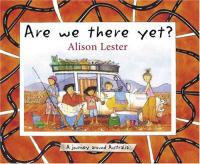
The year Grace turned eight, her Mum and Dad took her and her siblings on a trip around Australia. The kids “missed school for the whole winter term” and Grace documented much of what she learned, where she went, and the adventures they had as they experienced the diversity of the continent. Grace’s informal voice is informative yet engaging, completed by line drawings and simple maps.
Are We There Yet? A Journey Around Australia

Life as a paper-thin boy is not all bad as Stanley finds out. He was flattened by a bulletin board bit adjusts quite well with the help of his parents to his new dimensions — all of which makes for very funny reading (and travels in later books about Stanley and his family).
Flat Stanley: His Original Adventure
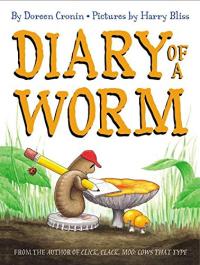
What icky creature looks the same from both ends? The worm, of course! For the first time ever, get the insider’s view of life from this creepy crawler’s perspective. He lives underground with his family, eats his homework and does his best to annoy his sister — documenting it all in a diary. Simple illustrations are the ideal complement to the understated humor (though nonetheless laugh-out-loud tone) of the text.
Diary of a Worm

Stunning close-ups of colorful frogs in their natural habitats taken by an acclaimed photographer and biologist combine with clearly presented information on large, bright pages, sure to intrigue as well as inform readers of all ages.

Children are encouraged to observe as experiment as they learn about wind and air as well as practice science writing by describing their findings.
I Face the Wind
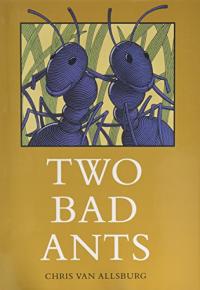
Separated from the colony, readers join two adventurous ants and see the world from a very different perspective.
Two Bad Ants
Liked it share it, topics this strategy is especially helpful for.
Mastering Hamburger Paragraph Writing: A Step-by-Step Guide

Introducing Hamburger Paragraph Writing
When it comes to teaching paragraph writing, the Hamburger Paragraph Writing technique stands out as an effective and engaging method. But what exactly is Hamburger Paragraph Writing ?
What is Hamburger Paragraph Writing?
In essence, Hamburger Paragraph Writing follows a structured approach similar to assembling a hamburger. Just like you layer ingredients in a burger, this technique helps students build well-organized paragraphs. It's all about understanding the Hamburger Technique .
Understanding the Hamburger Technique
The Hamburger Technique breaks down paragraph writing into distinct parts: a top bun (the main idea), fillings (supporting details), and a bottom bun (the conclusion). By visualizing paragraphs as hamburgers, students grasp the essential components easily.
Why Use the Hamburger Approach ?
The benefits of adopting the Hamburger Approach extend beyond just academic writing; it nurtures creativity too. In academic settings, this method enhances students' ability to structure their thoughts coherently. Moreover, in creative writing, it serves as a foundation for crafting compelling narratives and descriptive pieces.
Benefits in Academic and Creative Writing
In academic pursuits, mastering the Hamburger Paragraph Writing technique equips students with a clear framework for expressing their ideas effectively. When it comes to creative endeavors, this approach sparks imagination by providing a structured canvas for storytelling and expression.
The Layers of a Hamburger Paragraph
When it comes to paragraph writing , the Hamburger Model provides a structured approach that enhances organization and clarity. Let's delve into the layers of a hamburger paragraph to understand how this method can elevate your writing skills.
The Top Bun: Crafting a Strong Main Idea
At the heart of every well-constructed paragraph lies the main idea . This serves as the guiding light, directing the reader on what to expect. Crafting a good main idea sentence is akin to selecting the perfect top bun for your hamburger. It sets the tone and determines the flavor of your entire paragraph.
Incorporating a clear and concise topic sentence ensures that your main idea shines through. Just like a top bun holds together all the delicious fillings in a burger, a strong topic sentence unifies your supporting details, creating a cohesive and impactful paragraph.
The Hamburger Model assists in illustrating the organization or structure of ideas, showing how information is realistically connected. By teaching students how to develop a robust main idea, this method equips them with essential skills for effective communication.
The Fillings: Adding Supporting Details
After establishing your main idea, it's time to enrich your paragraph with flavorful supporting details . These details act as the meat, cheese, and veggies in your hamburger, adding depth and substance to your writing.
Including examples , facts , and vivid descriptions enhances the overall quality of your paragraph. Just as each filling contributes distinct flavors to a burger, diverse supporting details enrich your writing, making it more engaging and informative.
The Hamburger Model is an effective way to engage students in constructing organized paragraphs with ease . By providing a simple structure for discussing various topics, whether in presentations or essays, this approach encourages students to think critically and express their ideas coherently.
The Bottom Bun: Concluding with Impact
As you reach the end of your paragraph journey, it's crucial to conclude with impact. The bottom bun of your hamburger analogy represents the closure of your ideas—a chance to reinforce your main idea one last time.
Crafting a compelling conclusion involves summarizing key points while leaving a lasting impression on your readers. Just like a sturdy bottom bun supports all other ingredients in a burger, a well-crafted conclusion reinforces your main idea, leaving readers satisfied and fulfilled.
The Hamburger Model not only helps students practice writing but also guides them in constructing coherent paragraphs or essays effectively. Comparing paragraph structure to a hamburger offers an engaging way for students to grasp essential writing concepts while honing their communication skills.
By mastering each layer of the hamburger paragraph— from crafting a strong main idea to adding flavorful supporting details and concluding with impact—students can elevate their writing prowess and create compelling pieces that resonate with readers.
Crafting Your First Hamburger Paragraph
Now that you have grasped the essence of Hamburger Paragraph Writing and understand its significance in enhancing your writing skills, it's time to embark on crafting your first hamburger paragraph. Let's explore a guided step-by-step process to help you transition from planning to writing seamlessly.
Guided Step-by-Step Process
Planning stage:.
Brainstorm Ideas : Begin by brainstorming ideas for your paragraph topic. Consider what message or information you want to convey.
Outline Structure : Create a simple outline with your main idea (top bun) and supporting details (fillings). This step helps in organizing your thoughts cohesively.
Research : If needed, conduct research to gather relevant facts or examples that support your main idea.
Writing Stage:
Introduction (Top Bun) :
Start with a captivating topic sentence that encapsulates the main idea of your paragraph.
Ensure the topic sentence is clear and concise, setting the tone for the rest of the paragraph.
Body (Fillings) :
Develop each supporting detail with examples, facts, or descriptions that enrich your main idea.
Use transitions to connect these details smoothly, creating a logical flow within your paragraph.
Conclusion (Bottom Bun) :
Conclude your paragraph by summarizing the key points discussed.
Reinforce the main idea without introducing new information, providing closure to your reader.
Review your paragraph for coherence, clarity, and relevance.
Edit for grammar and punctuation errors to ensure a polished final draft.

Paragraph Writing Ideas to Get You Started
Prompts and inspiration:.
Health Information Technology :
Explore how advancements in health information technology have revolutionized patient care delivery systems.
NFL Sunday Ticket :
Discuss the impact of NFL Sunday Ticket on sports viewership habits and fan engagement in today's digital age.
Online Learning Platforms :
Share your experience with online learning platforms and how they have transformed traditional education methods.
Paragraph Writing Unit :
Reflect on a memorable paragraph writing unit you encountered in school and its influence on shaping your writing skills.
By following this structured approach and drawing inspiration from diverse topics, you can hone your paragraph writing abilities while exploring new ideas creatively.
Enhancing Your Paragraph Writing Skills
In the realm of paragraph writing , mastering the Hamburger Model is just the beginning. To elevate your skills further, exploring advanced techniques can add layers of depth and complexity to your writing. Let's delve into some strategies that will enhance your paragraph crafting prowess.
Advanced Hamburger Paragraph Writing Techniques
Diving deeper into the world of paragraph writing , advanced techniques offer a nuanced approach to constructing compelling narratives. By adding layers for depth and complexity, you can transform ordinary paragraphs into captivating pieces that engage readers on a profound level.
One technique to enhance your writing involves incorporating intricate supporting details that enrich your main idea. Just as a gourmet burger delights with diverse flavors, weaving in nuanced descriptions, insightful examples, and compelling facts can elevate your paragraph from good to exceptional. This approach not only engages readers but also showcases your ability to craft well-rounded and informative content.
Another aspect to consider is the art of crafting a concluding sentence that leaves a lasting impact on your audience. Much like the final bite of a delicious burger, a well-crafted conclusion ties together all elements of your paragraph, reinforcing the main idea and leaving readers satisfied. By mastering this skill, you can ensure that your paragraphs resonate with clarity and purpose.
Utilizing Writing Graphic Organizers
In the realm of paragraph writing , visual aids play a crucial role in organizing thoughts and enhancing coherence. One such tool is the Graphic Organizer , which serves as a visual roadmap for structuring ideas effectively. By utilizing graphic organizers, such as flowcharts or mind maps, you can streamline the writing process and ensure that each element of your paragraph aligns seamlessly.
Online resources offer a plethora of writing graphic tools that cater to various writing styles and preferences. These tools provide templates and frameworks designed to guide writers through the process of organizing their thoughts cohesively. Whether you prefer traditional outlines or interactive diagrams, these resources empower you to visualize your ideas and create well-structured paragraphs effortlessly.
By incorporating online graphic tools into your writing routine, you can enhance both efficiency and creativity in crafting engaging paragraphs. These resources not only streamline the planning process but also offer insights into effective organization techniques that elevate the quality of your content.
As you explore advanced techniques and embrace visual aids like graphic organizers, remember that practice is key to honing your paragraph writing skills. By experimenting with different approaches and leveraging online resources, you can refine your craft and develop a unique writing style that captivates audiences.
Incorporating these strategies into your writing repertoire will not only enhance the clarity and coherence of your paragraphs but also elevate the overall impact of your written work. Embrace these advanced techniques as stepping stones towards becoming a proficient writer who excels in conveying ideas with precision and flair.
Reflecting on Your Finished Paragraph
After diligently crafting your hamburger paragraph , it's essential to take a moment to reflect on your work. This stage involves reviewing and revising your paragraph to ensure clarity, coherence, and impact.
Reviewing and Revising Your Work
Upon completing your paragraph, engage in a process of self-assessment and seek peer feedback to gain valuable insights. Reflect on the effectiveness of your main idea sentence and the richness of your supporting details. Consider if your conclusion effectively ties back to the main idea, leaving a lasting impression on readers.
Incorporating feedback from peers allows for a fresh perspective on your writing. Constructive criticism can highlight areas for improvement and offer suggestions for enhancing the overall quality of your paragraph. Embrace feedback as an opportunity for growth and refinement in your writing skills.
Graphics Credits and Further Reading
As you refine your paragraph writing skills using the Hamburger Model , it's crucial to acknowledge the sources that have contributed to your learning journey. Giving due credit to graphic organizers or resources that have guided you in crafting good paragraphs is not only ethical but also demonstrates academic integrity.
Testimonials :
Elementary Island Blog :
"This hamburger essay guided paragraph approach has been very effective for my students and I know it will be with yours too! Keep the finished product in a writer’s notebook to show growth throughout the year!"
Anthony G. :
"This resource is highly recommended by myself for teachers who need to teach this material to their class."
Expanding your writing toolkit through additional reading materials enhances your understanding of paragraph writing techniques. Explore diverse perspectives on structuring paragraphs effectively, honing your skills further with each resource you encounter.
By reflecting on your finished paragraph, incorporating feedback, crediting valuable resources, and seeking further reading materials, you pave the way for continuous growth as a proficient writer.
About the Author : Quthor, powered by Quick Creator , is an AI writer that excels in creating high-quality articles from just a keyword or an idea. Leveraging Quick Creator 's cutting-edge writing engine, Quthor efficiently gathers up-to-date facts and data to produce engaging and informative content. The article you're reading? Crafted by Quthor, demonstrating its capability to produce compelling content. Experience the power of AI writing. Try Quick Creator for free at quickcreator.io and start creating with Quthor today!
Perfecting Your English Blog Writing Skills: Step-by-Step Tutorial
Creating a Powerful Opinion Blog Entry: Step-by-Step Tutorial
Writing an Effective Research Blog Post: Step-by-Step Tutorial
Becoming a Blogging Expert: Guidance for Psychology Today Writers
Crafting Top-Quality Blog Posts: Step-by-Step Tutorial for Novices
Loved This Read?
Blitz Your Engaging Blog Post Now with Quick Creator! Craft posts grounded in real facts, seamlessly integrate visuals and links, and effortlessly solve all your SEO woes.
© Copyright 2024 writing - All Rights Reserved.

Nursing program: Research skills: The "Hamburger Technique" of Writing
- Nursing Program
- Evaluating sources: C.A.R.S.
- Searching PubMed
- Reading Articles
- Health Statistics
- Advanced Google Use
- Professional Writing
- Avoiding Plagiarism
- The "Hamburger Technique" of Writing
- What is Evidence-Based Practice? (EBP)
- Finding EBP Resources
The "hamburger technique" of writing
The "hamburger technique" of writing.
It is important that the majority of your writing in a research paper is YOURS. Even if you are citing your sources, the general rule is that 2/3 of the words in your research assignments should be your own. If your paper consists of nothing but quotes, you are not demonstrating that you understand the material nor are you providing your own analysis of that material. One writing method you can follow to help you do this is called the hamburger paragraph .
Hamburger Paragraph:
- Some instructors will call this the sandwich paragraph method or even the Oreo method (which you may have heard before). Keep in mind that this method applies to body paragraphs, which are basically any paragraph in a paper other than the introduction and conclusion paragraphs.
Building the Burger:

- Top bun: The topic sentence, or argument. The first sentence of a paragraph should clearly state the paragraph’s main idea.
- Condiments: Your evidence (quotes & paraphrased information from your sources). When using quotes, remember that a little goes a long way!
- Cheese, pickles, onions, lettuce, tomato, burger: Your analysis. The bulk of the paragraph! This is where you explain the significance of the evidence in your own words. This section is crucial to your paragraph. Don't get caught in a quote trap. Which is stringing quotes together without explaining their purpose. If you do not back up your quotes or paraphrased information, your writing will be weak and your reader (which at TCC is your teacher) will not be convinced that you understand the material you are writing about.
- Bottom bun: Sentence relating the paragraph back to the thesis statement and transitioning to the next body paragraph.
Here's a diagram to illustrate the concept:
(click on image to enlarge)
Example with a paragraph:
Here is another example of a simple "evidence sandwich" paragraph in the middle of a research paper that paraphrases information about using social media in the classroom. If you were to use a direct quote instead of paraphrasing, this is where you would want to place the quote.
Variations on the hamburger method:
Remember...
- You can use variations on this formula. For example, you could make this paragraph longer by including more analysis of the researchers’ findings.
- Or you could include a second piece of evidence (more filling!) to further back up your point. If you add more filling, you might want to balance it by adding another slice of bread, too (that is, more of your own analysis).
Not every paragraph in your paper has to follow this formula, or even necessarily include outside evidence. But this is a classic formula that can serve you well throughout your college career. Just remember, you can't just plop a quote into a paragraph and move on - you must explain what the quote means or why the information is important in your own words - this is your analysis. Don't use quotes to fill space. Adding information into your paper should do just that, ADD to it - compliment it. Don't include useless information, but be picky and use quotes only when you intend to talk about what they mean and why they matter to your argument!
One Last Note:
And again, making sure you correctly paraphrase, quote, summarize and CITE is key to avoiding plagiarism!
Diagram source: " Paragraph burger " by M. Persson, 2013, Educational use.
- << Previous: Avoiding Plagiarism
- Next: What is Evidence-Based Practice? (EBP) >>
- Last Updated: Jun 13, 2024 9:35 AM
- URL: https://tacomacc.libguides.com/nursing

Tacoma Community College Library - Building 7, 6501 South 19th Street, Tacoma, WA 98466 - P. 253.566.5087

Visit us on Instagram!

Trinity disAbility Service
View the contact page for more contact and location information
- Supports & Resources
- Academic Support
- Essay and writing support
- How to Plan and Write an Essay
The Hamburger Essay Plan
Think of any essay as a hamburger and include all the key ingredients to make a great hamburger; link each one of these to a key point. This a particularly useful technique for exam essays as it can help you to check whether you have included all necessary information.
Gather all your ingredients – information that you have researched, class and seminar notes, readings……. now assemble the burger in the process illustrated on the next page down.
| Describe how you are going to answer the question, summarise the key points you are going to make, reflect the question………. are you comparing and contrasting, arguing, describing? |
| You can make a double or triple burger, put in as much meat in your burger as you like. These are the main points of each paragraph. |
| This is where you tie together the point, the example and the evidence and show how this relates to the question. |
| You can make a double or triple burger, put in as much meat in your burger as you like. These are the main points of each paragraph. |
| This is where you tie together the point, the example and the evidence and show how this relates to the question. |
| In the concluding paragraph you should restate the points you have made, together with any inferences, conclusions or recommendations that can be drawn, linking these to the question. |
Download the original Word document
Return to main essay writing page, return to main exam support page.
SHOP RESOURCES
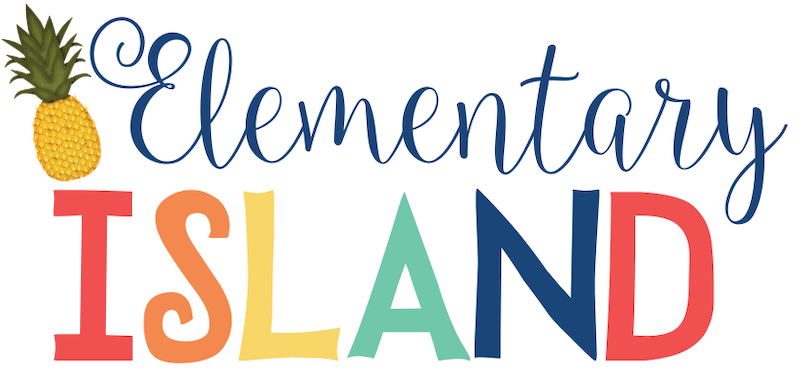
How to Teach Paragraph Writing with a Hamburger!
Writing a good, solid paragraph is the basis of writing composition. In fact, the ideas we teach our elementary students about paragraph writing will be used throughout their lives. Secondary school research projects need good paragraphs. College entrance essays need good paragraphs. Professional writing for any number of careers needs good paragraphs, too! So why not engage your students with something they love and make the concept of a good, solid paragraph stick? Teaching hamburger paragraph writing for elementary students using the hamburger style model is my favorite (and the most effective) way of teaching how to write a paragraph.
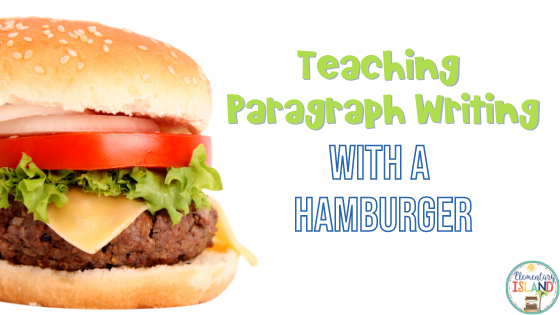
Teaching the Hamburger Model for Writing Using a Guided Approach
Over the years I have taught paragraph writing in many different ways. Some worked and some, well… not so much. One of the biggest things I’ve learned over the years is that teaching the paragraph as a whole and then sending my students off to write a paragraph is not the best approach. I now use a guided approach to teaching paragraph writing with much more success.
A guided approach involves breaking the task down into its parts and teaching each part individually. Once students have learned and practiced each part, then, and only then, do we put it all together to develop a full understanding of the topic. Here’s what it looks like in my classroom.
Introducing Hamburger Paragraph Writing for Elementary Students
On the first day, I love to engage my students with the hamburger. I mean, who doesn’t love a good, juicy hamburger? We will spend some time talking about hamburgers and what makes them so special, inviting their favorite restaurants into the discussion. We chat about our favorite hamburger toppings. And then, just about the time our mouths are watering, I let them know that hamburgers can teach us something too!
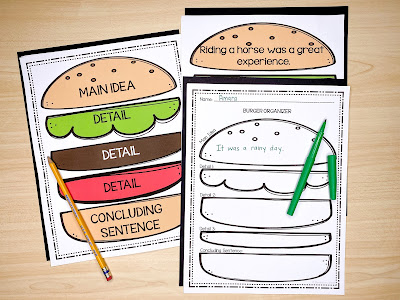
This is when I introduce the learning topic of paragraph writing. Depending on the grade level, the paragraph writing process might be something new or might be something they were introduced to the year before. Either way, our focus becomes learning to write a cohesive paragraph using the hamburger paragraph method.
Then, I begin by showing the students the hamburger paragraph graphic organizers. As we look at the model we identify the different types of sentences that make up a paragraph. Our focus will be the main idea (introduction sentence), supporting details, and the closing or concluding sentence.
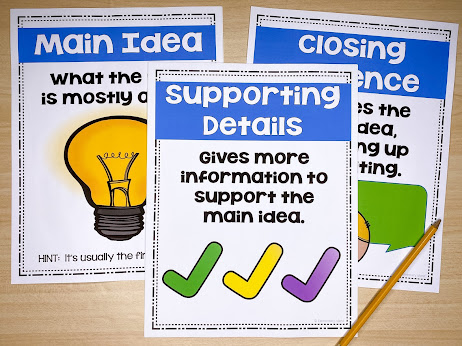
One of the first learning tools we use are these anchor chart pieces or posters for each sentence type. I have found this to be really helpful so that as we continue all students have been exposed to the same terms and language. We use these posters throughout the paragraph writing unit. They hang in the classroom as a reminder and learning tool for the students.
Focusing on the Main Idea
We begin with the topic sentence or the main idea of the paragraph. The main objective here is for students to understand that a paragraph is a group of sentences about one topic. The main idea sentence describes the topic of the paragraph. We go back to the full hamburger graphic to reinforce what the main idea does.
To help my students understand this concept we play a little game. I read or say complete sentences and my students tell me whether it would be a good main idea sentence. Some examples might be:
- Elephants are amazing animals. {Yes – this is a main idea sentence}
- An elephant has four legs. {No – not a main idea sentence}
- Percy Jackson has an adventurous life. {Yes}
- Percy Jackson went to Olympus and met Zeus. {No}
Once my students are doing a great job identifying main idea sentences, we then take our game to the next level. I give my students a general topic, like ‘animals’, and they brainstorm a different main idea or topic sentence that could be used.
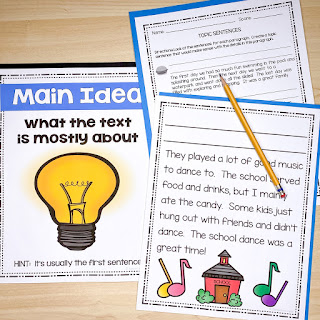
Students then practice doing this on their own or with a partner. It’s always fun to read some of their independent answers aloud for the class. This is a great way to show that there are many ways you can reword the same main idea.
A quick review of student answers gives me a really good idea of whether the class is ready to move on. If students need more practice, you should pause here and try other ways to teach the main idea to your students. Main idea is such an important concept in reading and writing that you want to make sure your students fully understand the topic.
We finish our lesson on main idea or a topic sentence with students practicing. We use the topic sentence worksheet to have student practice writing their own topic sentences for a provided paragraph.
Finally, we work on listening to a paragraph that doesn’t have an opening sentence. After hearing the paragraph we work on writing a good topic sentence for the paragraph. Not only does this help students work on writing the main idea in the form of a sentence, but it also helps them see how the different types of sentences in a paragraph work together.
Supporting Details
After a quick review of the main idea, we will next cover supporting details. The goal is for students to understand that supporting details give more information to explain and support the main idea. Before jumping in with sentences, we start with a hamburger. I start by holding up the top of a bun (real or a picture – both work). Then I ask my students if this is a hamburger? Obviously, the answer is a resounding NO! Then, I ask the students a simple question, “How do you build a hamburger?” The answers are pretty straightforward: bun, meat, cheese, ketchup, lettuce, tomato, etc.

Next, I ask the question that will connect building a hamburger to supporting details. I might say something like “What about the mashed potatoes?” To which my students usually stare at me like I’m crazy. Inevitably, someone will say something like ‘Mashed potatoes don’t go on a hamburger!’ And that is what I’m waiting for! I explain that they are absolutely right. And just like we build a hamburger with hamburger ingredients, we have to choose supporting details that support our main idea.
We again start by practicing this skill as a class. We start with a main idea sentence like “I had a horrible sick day.” I used this sentence, typed it out on a top bun, and displayed it on the board. Then I read a variety of other sentences and the students decide if the sentence supports the main idea.

For each sentence that does support the main idea, I display it on the board under the main idea. As we do this, students can see the progression of building the hamburger with a main idea and supporting details. Sometimes I may print these out and place them in centers for students to manipulate. I’m a fan of hands-on student engagement.
We do this a few times with different main ideas to give the students practice with identifying good supporting “juicy” details.
Another way to do this is to provide two main ideas, that are similar in context but different. For example, you could use “Riding a horse was a great experience.” and “Riding a horse is very scary.” Then as you read supporting detail sentences, students can choose which main idea the sentence best supports. This is really great if your students have experience with multi-paragraph writing. This activity shows them how they can break down different aspects of their topic to have multiple main ideas through multiple paragraphs.
The next day we tackle supporting details again. But this time our focus is on making sure that the supporting details are relevant to the main idea. I remind the students of the mashed potatoes from the day before. We talk about how mashed potatoes with a fried chicken dinner are great. They are relevant to completing that meal. But mashed potatoes on a hamburger just don’t work. They are not relevant even though they are a food and we could put a spoonful on the burger.
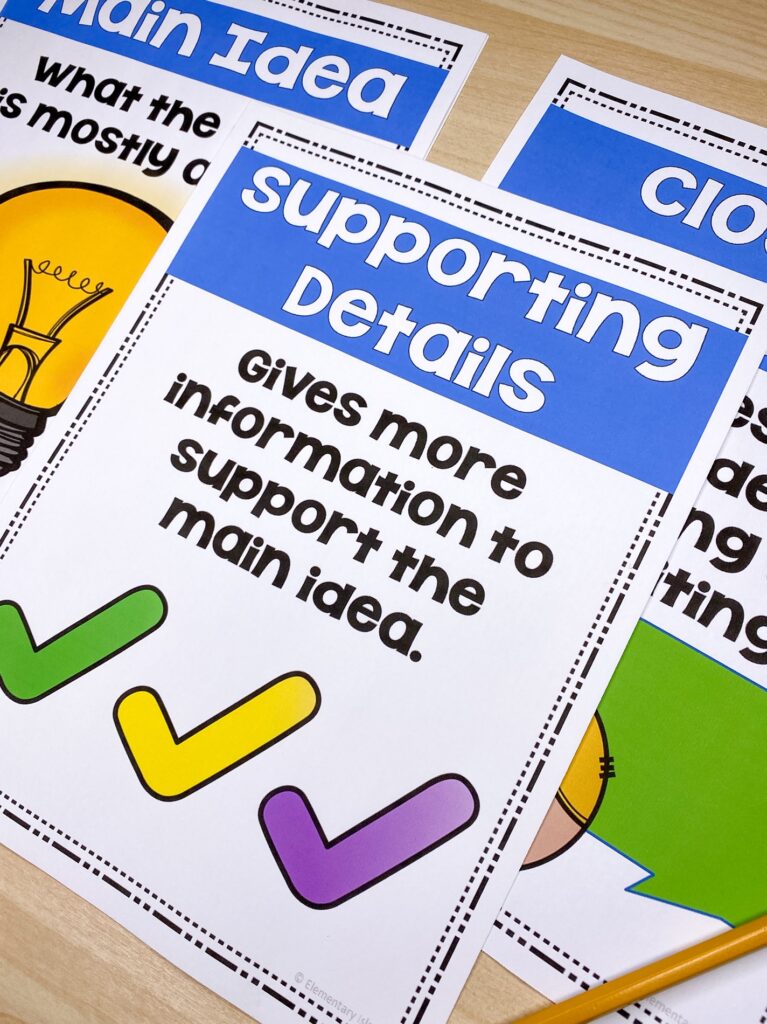
Like the mashed potatoes, even though it is possible to add them to a hamburger – we don’t. The same goes with supporting detail sentences. There may be sentences that relate to the main idea but that are not relevant. To help students understand this better we do some examples together.
I give students a topic sentence and a few supporting detail sentences. They then choose which sentences are relevant and which are not. We talk about what makes them relevant and why some sentences just don’t belong with this main idea.
After our group practice, students worked on this worksheet to practice taking out the sentences that were not relevant to the paragraph. Students can do this independently or with a partner. If they work with someone I have them explain the reason why they don’t feel a specific sentence is relevant.
After a few days of working on the main idea and supporting details, the students usually have a good understanding. If, however, your students are struggling with the concept, again, I would encourage you to not move on. There are amazing main idea and details worksheets to help assist with this progress.

MAIN IDEA & DETAILS SAMPLE FREEBIE
These main idea and details worksheets offer a perfect combination of practice for students from identifying the main idea and details from a set to writing them in on their own!
👉🏼 TRY A SAMPLE SET TODAY!
Concluding Sentences
Once students have a good grasp on the main idea and supporting details, it’s time to add the final bun to our hamburger. The bottom bun represents our closing or conclusion sentence. As I introduce the concluding sentence we talk about how the buns of a hamburger are what make it easy to eat. They hold together all the ‘messy’ stuff in the middle. While you could eat a hamburger with just one bun, it’s not quite as neat or convenient as with two buns. Just like the buns of a burger, the first and last sentences of a paragraph really hold the paragraph together for the reader.
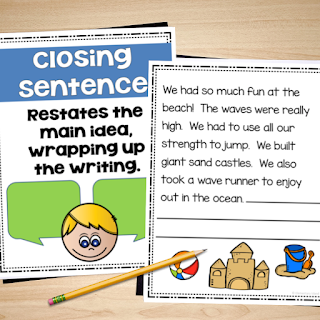
Students usually pick up the concept of concluding sentences quickly because they are similar to the main idea sentence. We talk about how rewording the main idea into a concluding sentence wraps up the paragraph.
We practice doing this with some simple paragraphs that are missing the closing or concluding sentence. After reading the paragraph we first identify the main idea sentence. Then we talk about ways we can reword the main idea into a conclusion.
That leads us right into our final lesson on closing sentences. We talk about different ways to make our closing sentences really good. I do this by introducing students to . . . the clincher!

The clincher is a way to make the closing sentence interesting – and not just a repeat of the main idea sentence. Students learn that there are a variety of ways to write a good clincher. These are the ones that I teach my students:
- asking a question;
- excitement; and
- reflection.
We dig into each of these types of clinchers by writing different sentences for the same paragraph. The students love using their creativity to come up with good clinchers!
Applying the Hamburger Structure to Writing
After learning about all the parts, it’s time to put the pieces together and start working on writing a good paragraph. So many times in the past, this is where I would start. As I look back now I see how much important learning my students were missing. It’s just one of the many things that makes me remember the value of learning in baby steps.

We finish up by going through the entire process again, together. But, we do this in steps too. I give students a very general writing topic just so that we all have a place to start. Then using the hamburger writing templates, we write out one sentence at a time using the hamburger model as a guide. Once students have completed the hamburger paragraph template they write their final paragraph.
Students also use a rubric to guide them through writing their paragraph. This helps them to remember the details and what to include. Before you know it, students will be writing their own paragraphs with very little guidance!
This hamburger essay guided paragraph approach has been very effective for my students and I know it will be with yours too! Keep the finished product in a writer’s notebook to show growth throughout the year!
Hamburger Paragraph Writing Unit
As a teacher, you are more than qualified to put together an amazing paragraph writing unit using these or other ideas. But if you are looking for some time-saving resources to help students in mastering the hamburger paragraph, this Paragraph Writing Lessons Resource may be what you’re looking for. This resource is perfect for 1st grade, 2nd grade, 3rd grade, and any remedial students.
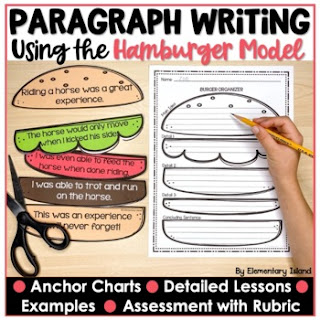
This ready-to-use resource includes everything you need to teach an entire paragraph unit using the paragraph hamburger model. You receive anchor charts and posters for the different types of sentences, the hamburger model, example paragraphs for guided practice, no prep worksheets for independent practice, the hamburger writing organizer, the coordinating paper for the final draft, and the grading rubric. All of this for the price of a Starbucks drink! You can find this Hamburger Paragraph resource in my Teachers Pay Teachers store .
Save these Hamburger Paragraph Writing Ideas
Not quite ready to add these ideas to your lesson plans? Just pin this to your favorite classroom Pinterest board so you can quickly come back when it is time to teach paragraph writing to your students.
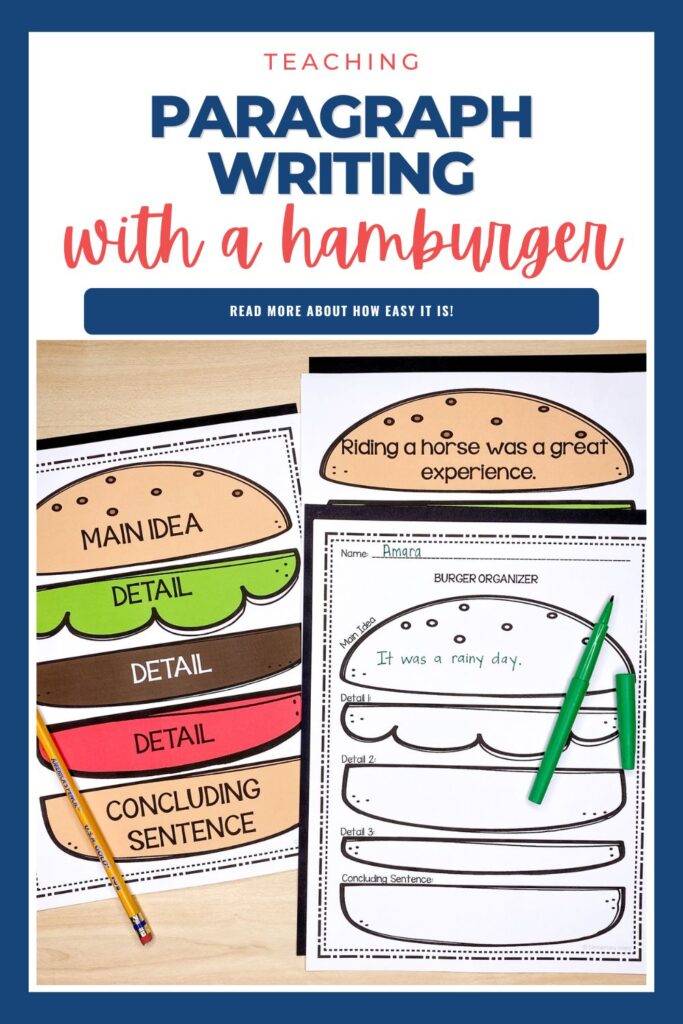
You May Also Enjoy...

JOIN THE EXCLUSIVE ISLAND CLUB TODAY!
Grab 4 weeks of my challenge phonics today for free.

- Classroom Management
- Teaching Ideas
- Online Catalogue
- 2024 Elementary Island
- Site design by Laine Sutherland Designs
- Privacy Policy
- Terms of Use
The Hamburger Method for Essay Writing

- Share article
While researching a longer piece on opioid use, our Education Week video team came across Briana Sotomayor—a 4 th grader in rural Jackson County, W.V., who wrote an award-winning essay for her district’s drug-and-alcohol prevention competition.
In this video, Briana describes an approach to essay writing used in many elementary classrooms across the country in which the image of a hamburger serves as a graphic organizer. The top bun is the thesis, the bottom bun the conclusion, and the meat, cheese, and veggies—the details—are sandwiched in between. Rhonda Jelich, the district’s director of elementary education and staff development, explained to Education Week that the hamburger model is one of many age-appropriate methods for giving all students a writing structure.
And since kids like hearing from kids, it’s the kind of short video teachers may want to show in their classrooms to get students going with the literacy strategy.
A version of this news article first appeared in the Curriculum Matters blog.
Sign Up for EdWeek Update
- International
- Education Jobs
- Schools directory
- Resources Education Jobs Schools directory News Search

Hamburger Essay Structure: Lesson Plans and Examples
Subject: English
Age range: 14-16
Resource type: Lesson (complete)
Last updated
21 November 2019
- Share through email
- Share through twitter
- Share through linkedin
- Share through facebook
- Share through pinterest

Hamburger Essay Structure helps students to understand and practice the ingredients that make a great essay. It answers questions like, how does my thesis statement relate to the body of my essay? What about the conclusion? Here’s an antidote to anxiety in the classroom. Immediately, you can use these lesson plans and activities that contain an element of fun. Coupled with fit-to-purpose resources, your students will build confidence and skills as they learn to -
• Understand and practice Hamburger Essay Structure • Create a robust Thesis Statement that sets them up for success. • Write Body Paragraphs using proven Point, Evidence, Analysis structure. • Edit ideas so that they have time for analysis. • Practice planning using a workable structure. • Stay motivated, right to the end.
Please contact Claire Vorster for free resources, or with other questions.
Resources included in this pack
Confidence building activities Mini and comprehensive writing / planning activities Examples of Simple to Advanced Thesis Statements Examples of Simple to Advanced Body Paragraphs Sample templates to build essay structure
Tes paid licence How can I reuse this?
Your rating is required to reflect your happiness.
It's good to leave some feedback.
Something went wrong, please try again later.
This resource hasn't been reviewed yet
To ensure quality for our reviews, only customers who have purchased this resource can review it
Report this resource to let us know if it violates our terms and conditions. Our customer service team will review your report and will be in touch.
Not quite what you were looking for? Search by keyword to find the right resource:
Why a Hamburger?

Essentially, what he -- and a lot of college professors want -- are formulaic essays that often lack the kind of artistry and creativity you may have developed and nutured. In fact, for English Language learners, the grades of the writing competency exams are graded based mastery of this formula. The "hamburger paragraph," often taught in elementary schools, provides a basic map outlining how the paragraph will begin, what it will contain, and how it will conclude. In fact, for English language learners, the writing placement exams are graded based mastery of this formula. --> Why a hamburger? Because the "structure" or a hamburger is surprisingly similar to the structure of academic paragraphs and essays with five main ingredients. The top bun, the three ingredient, and the bottom bun. Why three ingredients. Physcology has found that people remember three elements more than they remember other numbers. This is called the "rule of threes." In addition, having three elements allows you to elaborate on each. To keep people interested, however, it's best to go from the least-to-the-most important reasons: 1. The Top Bun (the Topic Sentence) 2. The Lettuce (the Least Important Reason) 3. The Tomato (the Next Most Important Reason) 4. The Meat (the Most Important Reason) 5. The Button Bun (the Conclusion) HamburgerParagraph.com starts with an outline and builds from there. Students never have to rewrite anything, even if they make changes For each type of paragraph or essay -- compare-and-contrast, cause-and-effect, persuasive -- the basic structure is slightly different, but if you start with a solid cause-and-effect paragraph you can build a cause-and-effect essay sentence by sentence, with the appropriate transitions. The hamburger structure gives the paragraph a plump hamburger shape . Each can be printed in a Word document. To see how this can help you write an essay? Let's start with The Top Bun
Hamburger Writing Template
Description
Our hamburger essay template guides you to structure your thoughts and ideas with a clear intro, body, and conclusion.
Terms of use apply.
Open with Kami to
Add text, images and videos
Leave interactive annotations
Collaborate in real-time
Assign to students
Edit in offline mode
Share | |
Related Templates
R.A.C.E Writing Template
The R.A.C.E. writing template is a method for organizing and structuring responses to essay questions or prompts. This template helps writers clearly and effectively address the task at hand, while also demonstrating their understanding of the topic through the use of evidence and analysis.
The Life of a Tree Reading Passage
Get ready for some fun learning! Our reading comprehension worksheets help you improve your reading skills and expand your knowledge!
Cursive Handwriting Worksheet | Sentences
Our captivating handwriting worksheet is designed to enhance penmanship skills for younger learners.
Hispanic Heritage Month | Reading Comprehension
Celebrate National Hispanic Heritage Month by reading & reflecting on its traditions. Enhance reading skills & cultural knowledge.
Explore Kami Library
Tap the on any templates you'd like to mix and match as a new file, totally free.
Download any templates for your K-12 classroom
Ready-to-use
100% accessible, no sign-in needed
Kami-compatible
Use Kami to personalize, assign and grade
How To Write an Essay
Make writing an essay as easy as making a hamburger
pointnshoot / Flickr / CC BY 2.0
- Writing Skills
- Pronunciation & Conversation
- Reading Comprehension
- Business English
- Resources for Teachers
Structuring the Essay (aka Building a Burger)
Choosing a topic, drafting the outline, creating the introduction, writing the body of the essay, concluding the essay.
- TESOL Diploma, Trinity College London
- M.A., Music Performance, Cologne University of Music
- B.A., Vocal Performance, Eastman School of Music
Writing an essay is like making a hamburger. Think of the introduction and conclusion as the bun, with the "meat" of your argument in between. The introduction is where you'll state your thesis, while the conclusion sums up your case. Both should be no more than a few sentences. The body of your essay, where you'll present facts to support your position, must be much more substantial, usually three paragraphs . Like making a hamburger, writing a good essay takes preparation. Let's get started!
Think about a hamburger for a moment. What are its three main components? There's a bun on top and a bun on the bottom. In the middle, you'll find the hamburger itself. So what does that have to do with an essay? Think of it this way:
- The top bun contains your introduction and topic statement. This paragraph begins with a hook, or factual statement intended to grab the reader's attention. It is followed by a thesis statement, an assertion that you intend to prove in the body of the essay that follows.
- The meat in the middle, called the body of the essay, is where you'll offer evidence in support of your topic or thesis. It should be three to five paragraphs in length, with each offering a main idea that is backed up by two or three statements of support.
- The bottom bun is the conclusion, which sums up the arguments you've made in the body of the essay.
Like the two pieces of a hamburger bun, the introduction and conclusion should be similar in tone, brief enough to convey your topic but substantial enough to frame the issue that you'll articulate in the meat, or body of the essay.
Before you can begin writing, you'll need to choose a topic for your essay, ideally one that you're already interested in. Nothing is harder than trying to write about something you don't care about. Your topic should be broad or common enough that most people will know at least something about what you're discussing. Technology, for example, is a good topic because it's something we can all relate to in one way or another.
Once you've chosen a topic, you must narrow it down into a single thesis or central idea. The thesis is the position you're taking in relation to your topic or a related issue. It should be specific enough that you can bolster it with just a few relevant facts and supporting statements. Think about an issue that most people can relate to, such as: "Technology is changing our lives."
Once you've selected your topic and thesis, it's time to create a roadmap for your essay that will guide you from the introduction to conclusion. This map, called an outline, serves as a diagram for writing each paragraph of the essay, listing the three or four most important ideas that you want to convey. These ideas don't need to be written as complete sentences in the outline; that's what the actual essay is for.
Here's one way of diagramming an essay on how technology is changing our lives:
Introductory Paragraph
- Hook: Statistics on home workers
- Thesis: Technology has changed work
- Links to main ideas to be developed in the essay: Technology has changed where, how and when we work
Body Paragraph I
- Main idea: Technology has changed where we can work
- Support: Work on the road + example
- Support: Work from home + example statistic
Body Paragraph II
- Main idea: Technology has changed how we work
- Support: Technology allows us to do more on our own + example of multitasking
- Support: Technology allows us to test our ideas in simulation + example of digital weather forecasting
Body Paragraph III
- Main idea: Technology has changed when we work
- Support: Flexible work schedules + example of telecommuters working 24/7
- Support: Technology allows us to work any time + example of people teaching online from home
Concluding Paragraph
- Review of main ideas of each paragraph
- Restatement of thesis: Technology has changed how we work
- Concluding thought: Technology will continue to change us
Note that the author uses only three or four main ideas per paragraph, each with a main idea, supporting statements, and a summary.
Once you've written and refined your outline, it's time to write the essay. Begin with the introductory paragraph . This is your opportunity to hook the reader's interest in the very first sentence, which can be an interesting fact, a quotation, or a rhetorical question , for instance.
After this first sentence, add your thesis statement . The thesis clearly states what you hope to express in the essay. Follow that with a sentence to introduce your body paragraphs . This not only gives the essay structure, but it also signals to the reader what is to come. For example:
Forbes magazine reports that "One in five Americans work from home". Does that number surprise you? Information technology has revolutionized the way we work. Not only can we work almost anywhere, we can also work at any hour of the day. Also, the way we work has changed greatly through the introduction of information technology into the workplace.
Notice how the author uses a fact and addresses the reader directly to grab their attention.
Once you've written the introduction, it's time to develop the meat of your thesis in three or four paragraphs. Each should contain a single main idea, following the outline you prepared earlier. Use two or three sentences to support the main idea, citing specific examples. Conclude each paragraph with a sentence that summarizes the argument you've made in the paragraph.
Let's consider how the location of where we work has changed. In the past, workers were required to commute to work. These days, many can choose to work from the home. From Portland, Ore., to Portland, Maine, you will find employees working for companies located hundreds or even thousands of miles away. Too, the use of robotics to manufacture products has led to employees spending more time behind a computer screen than on the production line. Whether it's in the countryside or in the city, you'll find people working everywhere they can get online. No wonder we see so many people working at cafes!
In this case, the author continues to directly address the reader while offering examples to support their assertion.
The summary paragraph summarizes your essay and is often a reverse of the introductory paragraph. Begin the summary paragraph by quickly restating the principal ideas of your body paragraphs. The penultimate (next to last) sentence should restate your basic thesis of the essay. Your final statement can be a future prediction based on what you have shown in the essay.
In this example, the author concludes by making a prediction based on the arguments made in the essay.
Information technology has changed the time, place and manner in which we work. In short, information technology has made the computer into our office. As we continue to use new technologies, we will continue to see change. However, our need to work in order to lead happy and productive lives will never change. The where, when and how we work will never change the reason why we work.
- Writing Cause and Effect Essays for English Learners
- Persuasive Writing: For and Against
- Paragraph Writing
- Personal Descriptions
- Sentence Connectors and Sentences
- Writing About Cities
- Writing Sentences for Beginners
- Complex Sentence Worksheet
- How to Use Sentence Connectors to Show Contrast
- Learn to Order Events for Narrative Writing Assignments
- Parallel Structure
- Writing Descriptive Paragraphs
- How to Use Sentence Connectors to Express Complex Ideas
- Beginning Writing Short Writing Assignments
- Sentence Patterns
- Compound-Complex Sentence Worksheet
Topbar Social Icons

Hamburger Paragraph Planning

- top bun= introduction
- three layers (mine are lettuce, burger and cheese)= three strong supports
- bottom bun= conclusion

- CCSS.ELA-Literacy.W.3.1 Write opinion pieces on topics or texts, supporting a point of view with reasons.
- CCSS.ELA-Literacy.W.3.1a Introduce the topic or text they are writing about, state an opinion, and create an organizational structure that lists reasons.
- CCSS.ELA-Literacy.W.3.1b Provide reasons that support the opinion.
- CCSS.ELA-Literacy.W.3.1d Provide a concluding statement or section.

Hi Stephanie, What a cute pack! I LOVE the hamburger idea! Standardized testing is the pits! We have to do it in 3rd grade in Australia too, ours was earlier in the year - our writing was persuasive (exposition) very tricky! Alison Teaching Maths with Meaning

Thanks, Alison! I can't believe your tests were so early :( Our's are a few months before school and I thought that was bad! Hope you have a wonderful weekend and thanks for stopping by :) ~Stephanie

Your packet looks wonderful!!! I have used the hamburger idea before and my kids always enjoyed it!! Tammy Come on over and join my Christmas Linky:) http://www.123teachwithme.com/2012/11/fun-christmas-linky.html 1...2...3...Teach With Me ”Dots” of Fun!
You're so sweet, Tammy- thank you! ~Stephanie

I also use the hamburger idea when teaching paragraphs...but your packet is so adorable...I'm thinking of going over to grab them right now. Thanks for sharing!
You're so sweet, Kathy, thanks! I know your kids will love it as much as mine did- they were loving coloring in their own mini-notebook helpers and having conversations about their favorite toppings :) Thanks for stopping by and have a great weekend! ~Stephanie
Join the mailing list

Essay Mapping Tool
Instructions.
Effective writing at university is a process:
Analyse the task → Gather content → Plan → Draft → Edit
This tool may help you to bridge from planning to drafting by helping you arrange your sentences in a logical order. It also provides tips for each component of an essay – the introduction, body, and conclusion. It can be used to improve your understanding of essay writing in general or as a planning tool for one of your university assignments.
Because this tool is for your personal use only, you may decide to write in bullet points, but we recommend full sentences. Once you have filled in each section, a complete essay overview will be generated which can be printed.
1. Introduction
Three paragraphs planning spaces have been provided for you. You can add or delete as necessary.
The purpose of the body is to logically develop the points made in your thesis and outline statements. There are no rules about the number of paragraphs required in assignment, but in general, you are advised to develop one idea per paragraph. This is done with a clear and coherent structure which introduces the topic in a topic sentence, defines or clarifies which aspect of the topic you are going to discuss, develops and supports your discussion and (optionally) concludes your discussion.
A topic sentence generally has two parts. You may refer to the overall essay topic and also introduce the specific aspect you plan to discuss in this paragraph. This is referred to as topic + controlling idea . You can also use a topic sentence to link to or contrast with the previous paragraph. This is an effective strategy to use with the second body paragraph onwards. You may choose to conclude the paragraph with a summary sentence; however, you are advised not to overuse this type of sentence as it may seem repetitious.
Cohesion and coherence refer to how effectively sentences are connected and how smoothly the writing flows. This is not simply achieved by following a logical paragraph structure, but also by using linking words (e.g. however/furthermore/consequently ) and referring words (e.g. this/that/these/those )
When you develop your argument, remember to use a range of support. You can use examples, logical reasoning, speculation, statistics and citations
Paragraph 1
Write the topic and controlling idea (one sentence).
Support your controlling idea using evidence, examples, elaboration or explanations. Do not go off topic. Do use in-text references.
Sum up the paragraph and link to your thesis OR link to the next paragraph (one sentence).
Paragraph 2
Paragraph 3, 3. conclusion.
The purpose of the conclusion is to summarize the key points you have discussed; however, it often contains a paraphrase of the thesis statement. This helps link the whole essay together. A conclusion may also contain a statement which links the essay to the broader topic or suggests a future action.
You can begin with the phrase ' In conclusion, ' but there are other phrases you could consider: In summary/This assignment has…/In this essay, I have… . Avoid Finally/Briefly/
Remember to reference any sources you have used. Refer to CDU Library for more information on referencing.
Introduction
To save as a PDF, click the Print button and then change your printer destination to "Save As PDF".
Scroll for more content

Homeschool Creations
Homeschool blog featuring free homeschool printables, information on how to homeschool, a yearly homeschool planner, homeschool curriculum, and more!
- Our Curriculum
- Our Classroom
- Our Planner
- Privacy Policy
- Weekly Linkup
- Ask Mr. Bear
- Blueberries for Sal
- Caps for Sale
- Gingerbread Baby
- Goodnight Moon
- If Jesus Came to My House
- In the Castle
- Jack’s Garden
- Mr. Willowby’s Christmas Tree
- On a Pirate Ship
- On the Moon
- Prayer for a Child
- The ABC Bunny
- The Red Carpet
- The Runaway Bunny
- The Snowy Day
- We’re Going on a Bear Hunt
- Color Matching Cards
- Chore Charts
- Colors & Shapes
- Handwriting
- Learning Songs
- Literature Based
- Phonics & Reading
- Read, Build, Write Mats
- Fruit and Vegetable Matching
- Number Playdough Mats
- Number Matching Cards
- Number Tracing Cards
- Gingerbread
- Thanksgiving
- Transportation
- Valentine’s Day
- Wizard of Oz
- Preschool Planning Forms
- Tot School Planning Form
- Preschool Corner Posts
- Join in Weekly
- ABC Flashcards & Posters
- ABC Phonics Poster
- Playdough Mats
- Alphabet Printables
- All About Reading PreK
- Alphabet Book
- Alphabet Worksheets
- Beginning Consonants
- Do a Dot Pages A-M
- Do a Dot Pages N-Z
- Handwriting Without Tears
- Lowercase Tracing Cards
- Uppercase Tracing Cards
- Uppercase/Lowercase Matching
- Vowel Picture Cards
- ABC Verse Flashcards
- Bible Verse Printables
- Illustrating Verses
- Prayer Cards
- SOAP Study Method
- Seeds Family Worship
- Loving God and His Word
- Learning God’s Word Through Music
- Illustrating Bible Verses
- Raising Rock Stars Curriculum
- Making God’s Word Come Alive
- SOAP Study Printables
- In My Heart Printables
- Preschool Bible Verse Printables
- The Honest Truth
- 10 Tools for Teaching Geography
- Geography Resources – Top Picks
- Africa Printables
- Asia Printables
- Australia Printables
- Europe Printables
- North America Printables
- South America Printables
- World Flag Cards
- State Notebooking Pages
- Homeschool Basics
- Homeschool Planner
- Free Printables
- Our School Room
- Calendar and Morning Board
- Calendar Notebook
- Homeschool Binder
- Organizing School Paperwork
- Workbox Weekly Grid
- Peel and Stick Chalkboards
- Blog Planner
- Daily To Do List
- Monthly Menu Planner
- Weekly Meal Planner
- Freezer Cooking Labels
- Printables from A to Z
- Assignment Sheets
- Book Report & Reading Log
- PreK & K
- Skip Counting Charts
- Read! Build! Write!
- Weekly Homeschool Planner (editable)
- Student Planner
- Yearly Home Planner – Organize your Days
- Pocket Chart Calendar Cards – Monthly and Holiday Pieces
- Pocket Chart Holiday and Special Occasion Calendar Cards
- Favorite Resources
- Preschool Favorites
- Reading Curriculum
- Spelling Curriculum

Hamburger Essay Outline – Free Writing Printable
This post may contain affiliate or advertiser links. Read my full disclosure policy .
- Odnoklassniki icon Odnoklassniki
- Facebook Messenger
- LiveJournal
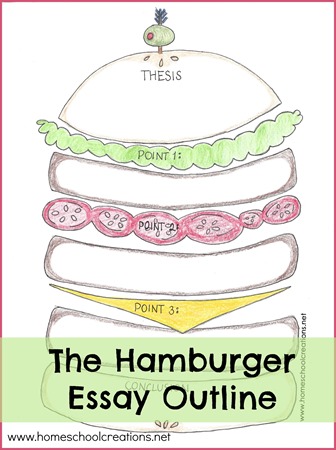
This year we’ve been working on essay writing in one of our co-op classes. A lot. The kids are at different points with their writing skills: a few of them are all about writing out a detailed outline, complete with color coded paragraphs, while a few others need a more visual approach to grasping the concept of outlining.
Just for fun, I asked Laurianna to help me create a visual outline that would give everyone a little start on writing and completing a five paragraph essay. Their essays and the outline needed to include:
- three key points/paragraphs
- a conclusion
One of the things that I continually stress to our kids is the importance of being able to write a strong thesis and/or introduction, make valid points that support and prove their thesis, and then end with a strong concluding paragraph to tie it all together. Sometimes a simple visual can help them map their thoughts, make sure things flow together properly, and ensure they aren’t getting off topic.
The kids can start with the hamburger essay outline to map out their initial thoughts, and eventually they build a more detailed essay outline like below:
- Thesis and ‘hook’ sentence
- Main paragraph idea #1: sub-points 1, 2, and 3
- Main paragraph idea #2: sub-points 1, 2, and 3
- Main paragraph idea #3: sub-points 1, 2, and 3
The hamburger essay outline is just a simple pencil/pen sketch that we had fun coloring in, but it has been a help to several of our kids and the kids in co-op – and we wanted to share it with you all as well!

p.s. on a completely unrelated note to anything, it just makes me giggle saying ‘hamburger’ because then I picture Steve Martin as the Pink Panther trying to say the word hamburger… and I get completely sidetracked.
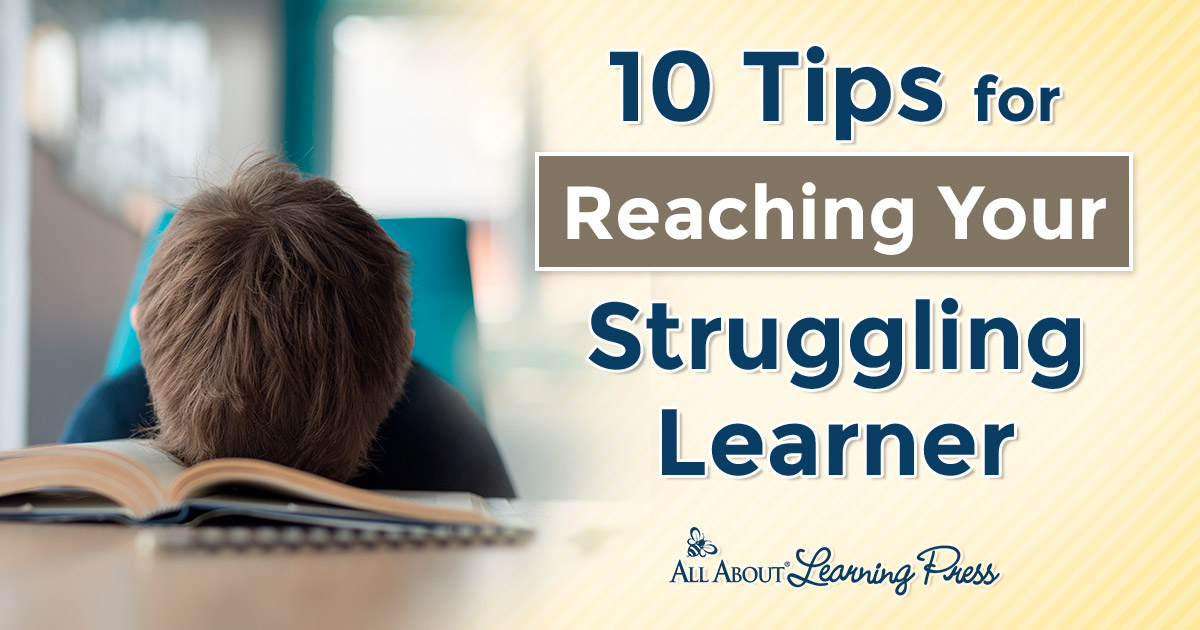
Leave a Comment Cancel reply
Looking for something.

A Little About Me
Hello! My name is Jolanthe {pronounced Yo-lawn-the}. On my site, you will find a listing of free educational printables , helpful tips and resources for families, encouragement for your homeschool journey , and a homeschool planner to help you get organized . Feel free to contact me with questions!

All About Spelling Review
All about reading review, nancy larson science, teaching textbooks review.

Check the Archives

Top of Page
© 2007–2024 HomeschoolCreations.com . All rights reserved.

IMAGES
VIDEO
COMMENTS
1. The top bun (a.k.a the introduction paragraph) The hamburger essay begins with a strong introduction paragraph (the top bun) that sets up the rest of the paper and presents the essay's primary thesis statement or argument. In high school, students are often taught to begin their introduction paragraph with the broadest or most general information first, and gradually narrow in on the ...
Hamburger Paragraph Template for Essay Writing. It almost sounds like something you might see on a menu at a fast-food restaurant, but a "hamburger paragraph" is a method of essay writing often taught in schools to help students structure their paragraphs effectively. Just as a burger consists of various layers that come together to create a satisfying whole, an essay is built up of ...
2. Add a detail as your tomato. The tomato is going to be a detail. A detail should some how connect with the topic sentence. An example is: "Allie is always there for me, no matter what." [2] 3. Layer on another detail as the cheese. The cheese is going to be another detail that connects with the topic sentence.
Burger meat: the main points You can make a double or triple burger, put in as much meat in your burger as you like. These are the main points of each paragraph. Bottom bun: the conclusion In the concluding paragraph you should restate the points you have made, together with any inferences, conclusions or recommendations that
Enter the Burger Method, a creative and engaging strategy that teaches organization and development in writing. Similar to how a delicious burger comprises various layers, a well-crafted paragraph consists of essential elements like the main idea sentence, supporting details, and a concluding sentence. This method not only simplifies the ...
How to use the paragraph hamburger organizer. Discuss the three main components of a paragraph, or story: The introduction (top bun) The internal or supporting information (the filling) The conclusion (bottom bun) Ask students to write a topic sentence that clearly indicates what the whole paragraph is going to be about.
After establishing your main idea, it's time to enrich your paragraph with flavorful supporting details. These details act as the meat, cheese, and veggies in your hamburger, adding depth and substance to your writing. Including examples, facts, and vivid descriptions enhances the overall quality of your paragraph.
© 2016 Understood for All, Inc. A paragraph is like a hamburger — they both have several layers. Use this graphic organizer to help build a juicy paragraph.
Here are the parts for an effective hamburger (or veggie burger) paragraph: Top bun: The topic sentence, or argument. The first sentence of a paragraph should clearly state the paragraph's main idea. Condiments: Your evidence (quotes & paraphrased information from your sources). When using quotes, remember that a little goes a long way!
The Hamburger Essay Plan. Think of any essay as a hamburger and include all the key ingredients to make a great hamburger; link each one of these to a key point. This a particularly useful technique for exam essays as it can help you to check whether you have included all necessary information. Gather all your ingredients - information that ...
The main objective here is for students to understand that a paragraph is a group of sentences about one topic. The main idea sentence describes the topic of the paragraph. We go back to the full hamburger graphic to reinforce what the main idea does. To help my students understand this concept we play a little game.
In this Education Week video, a 4th grader describes an approach to essay writing used in many elementary classrooms across the country in which the image of a hamburger serves as a graphic organizer.
Coupled with fit-to-purpose resources, your students will build confidence and skills as they learn to -. • Understand and practice Hamburger Essay Structure. • Create a robust Thesis Statement that sets them up for success. • Write Body Paragraphs using proven Point, Evidence, Analysis structure. • Edit ideas so that they have time for ...
The Hamburger Paragraph is an organizer which uses the analogy of hamburger ingredients, to encourage your students to write better detailed, descriptive par...
5. The Button Bun (the Conclusion) HamburgerParagraph.com starts with an outline and builds from there. but if you start with a solid cause-and-effect paragraph you can build a cause-and-effect essay sentence by sentence, with the appropriate transitions. The hamburger structure gives the paragraph a plump hamburger shape.
The R.A.C.E. writing template is a method for organizing and structuring responses to essay questions or prompts. This template helps writers clearly and effectively address the task at hand, while also demonstrating their understanding of the topic through the use of evidence and analysis. ... Whatever you plan to do with them, just be sure it ...
Do you know how to write a good paragraph in English? In this lesson, Mr. P. will show you how to produce an easy example paragraph and go over it step by st...
Give details about your topic. Make sure you have at least 3. Close out your writing with a finishing sentence about your topic. www.thisreadingmama.com. Topic Sentence. Detail #1. Detail #2. Detail #3. Detail #4.
Writing an essay is like making a hamburger. Think of the introduction and conclusion as the bun, with the "meat" of your argument in between. The introduction is where you'll state your thesis, while the conclusion sums up your case. Both should be no more than a few sentences. The body of your essay, where you'll present facts to support your ...
I am blessed with a lot of lovely, creative writers, but on the whole, we really need to work on focusing our thinking :) The structure of the Hamburger Paragraph Plan is: top bun= introduction. three layers (mine are lettuce, burger and cheese)= three strong supports. bottom bun= conclusion. The prompt we started with actually came from our ...
Analyse the task → Gather content → Plan → Draft → Edit. This tool may help you to bridge from planning to drafting by helping you arrange your sentences in a logical order. It also provides tips for each component of an essay - the introduction, body, and conclusion. It can be used to improve your understanding of essay writing in ...
The kids can start with the hamburger essay outline to map out their initial thoughts, and eventually they build a more detailed essay outline like below: Thesis and 'hook' sentence. Main paragraph idea #1: sub-points 1, 2, and 3. Main paragraph idea #2: sub-points 1, 2, and 3. Main paragraph idea #3: sub-points 1, 2, and 3.
The Hamburger Writing Template has been created by our dedicated team of teachers and designers with the aim of making your planning and lesson delivery that little bit easier. The template encourages your students to think about essay writing in the same way one may assemble a burger. If all the essential, recognisable parts of a burger come ...